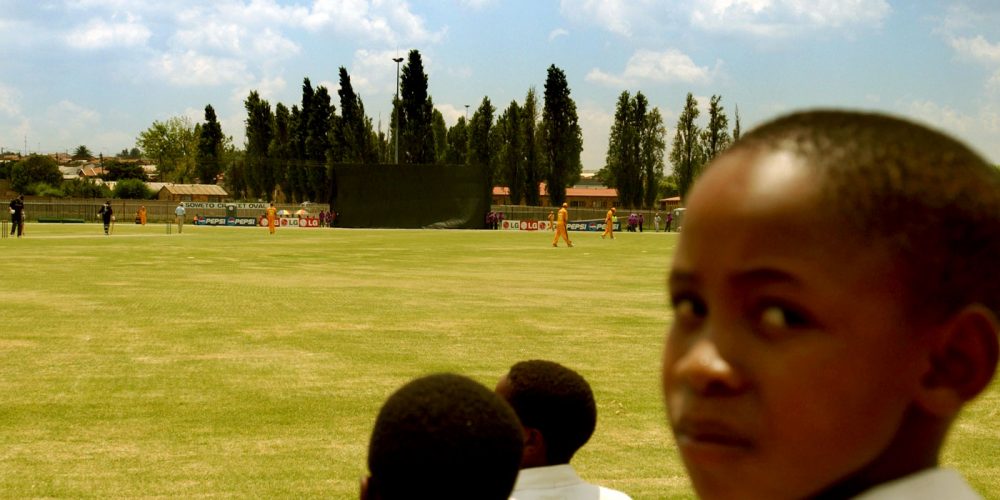Soweto Cricket Oval
The Soweto Cricket Oval in Moroka, Soweto, was built on what was previously a marshy, reed-covered vlei. This resulted in the field constantly being permeated by large amounts of subsurface water. However, the installation of the Shelton Drainage System has transformed the field into one on which cricket matches can now successfully be played.
In addition to the marshy conditions, a 100mm heavily compacted layer of clayey material was placed below the surface of the field when it was constructed. The overlying clayey topsoil was consequently easily saturated, causing many a cricket match to be postponed or abandoned, even though the Soweto Cricket Club is a Premier League cricket side. Because of the frequent ponding on the field, the salts had leached out of the clayey soil, leaving many unsightly white, salt-encrusted dead grass patches.
The Shelton drainage system was chosen to sort out the problems of the waterlogged fields because of its proven ability to clear excess sub-surface water within a predetermined me period. The intensity of the system installed will ensure that play can continue within 30 to 60 min after 25mm of rain. The drainage installed will be the foundation in the upgrade of the field, prior to it being used by the United Cricket Board for matches for the Cricket World Cup 2003.
Installation
The Shelton Drainage System installed consisted of the following elements:
- main drain: 110mm diameter Cordrain pipe on the bottom edge of the field. The pipe collects the water from the 65mm diameter pipes and leads it off the field;
- secondary drains; 65mm diameter Cordrain performated pipes placed at 5m centres across the field at a depth of 450 – 500mm:
- gravel bands; 25mm wide by 200 – 250mm deep, placed at 400mm centres transverse to the 65mm Cordrain piping;
- additional 65mm diameter drains and gravel bands in front of the pavilion: and
- and open drain was constructed to collect the surface runoff water and the flow from the drainage pipes. The drain takes the water to the adjacent river and prevents the water flooding the adjacent soccer fields. A TLB (tractor, loader backhoe) was used to dig the drain.
The 65mm diameter perforated Cordrain pipes were placed in a 78mm wide trench and the trench was filled with fine gravel to within 30 – 50mm of the surface. The trenches were then topped up with a washed coarse river sand/topsoil mixture. The 110mm diamater pipe was similarly placed in a 125mm trench. The Cordrain piping was specifically chosen because of the corrugated internal surface which causes the water flow to be turbulent. The turbulent flow flushes any particles of soil out of the pipe on a continuous basis by bumbling the particles along with the flow.
Special consideration had to be given to the planning of the installation to alow for the two practice pitches set in the onfield, and a future extension to the central pitch.
The very wet, heavy clay cnditions meant that Shelton had to change its normal modus operandi and use the Shelton agricultural trencher to cut about 50% of the trenches. This machine had an open blade and deposits the soil alongside the trench for later uplifting and removal. All the material arising from the trenches was used to create a raised area for spectators adjacent to the south side of the field in an area which is normally not used
In order to test the system, the irrigation was applied for a prolonged period and within 10 minutes of starting to irrigate the field, the excess water was straming out of the outlet pipes.
On completion of an installation, Shelton’s normal recommendation is to change the irrigation cycle to shorter periods more frequently. The ideal cycle can be observed with the first irrigation application by recording the time it takes for the excess water to start flowing from the outlet pipe. This leads to water savings and will achieve the best horticultural advantages of an effective subsurface drainage system. The horticultural advantages are:
- control of water content in the all important root zone, the top 250 – 300mm of the soil profile;
- the root system develops fully and is never allowed to drown. Drowning causes roots to start dying within 24 hours.
- earthworms are never drowned and the regenerative function of the soil is assured:
- once the root system is fully developed water savings of up to 50% can be expected;
- facilitates the essential feeding of oxygen to the roots;
- allows the release of bad gases generated in the root zone. Recent research has shown this to be an important factor in healthy grass development; and the natural cappilary action taking moisture upwards to the root system is not prevented as with a blanket type drainage system. A blanket system would necessitate far greater consumption of irrigation water the root system is not prevented as with a blanket type drainage system.
The clean working equipment with its narrow trenching and gravel banding enabled the Soweto Cricket Club to host a match against the touring New Zealand side on 18 October 2000
Brian Basson, Director of Umpiring, United Cricket Board, was very pleased with the end result. “What used to be a quagmire is now a playable field as a result of the correct drainage system having been installed”: he says
Ruben Tseladimitlwa, Chairman of the Soweto Cricket Club and an executive member on the Gauteng Cricket Board, also confirms the success of the system. “We are more than satisfied with the end result. Since the drainage was installed, we have observed that the field is dry and playable as quickly as ten minutes after a downpour of rain.”
